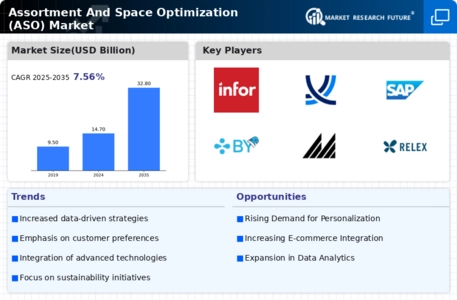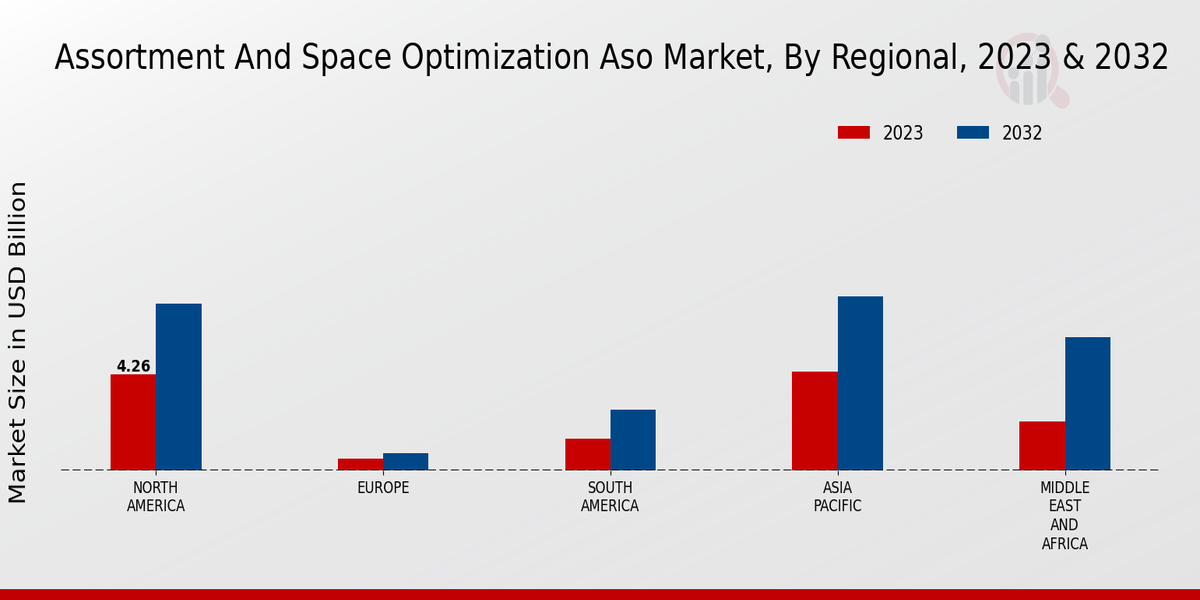Market Growth Projections
The Global Assortment And Space Optimization (ASO) Market Industry is poised for substantial growth, with projections indicating a market size of 14.7 USD Billion in 2024 and an anticipated increase to 32.8 USD Billion by 2035. This growth trajectory suggests a compound annual growth rate (CAGR) of 7.57% from 2025 to 2035. Such figures highlight the increasing recognition of the importance of effective assortment and space optimization strategies among retailers. As businesses continue to invest in ASO solutions, the market is likely to evolve, adapting to changing consumer demands and technological advancements.
Expansion of E-commerce Platforms
The expansion of e-commerce platforms significantly impacts the Global Assortment And Space Optimization (ASO) Market Industry. As online shopping continues to gain traction, retailers are compelled to optimize their assortments for digital channels. This shift necessitates a reevaluation of product offerings and space allocation to cater to diverse consumer preferences across various platforms. The growing importance of omnichannel retailing encourages businesses to adopt ASO strategies that ensure consistency in product availability and presentation. This trend is expected to contribute to the market's robust growth, with a projected CAGR of 7.57% from 2025 to 2035.
Growing Focus on Customer Experience
The Global Assortment And Space Optimization (ASO) Market Industry is increasingly influenced by a growing focus on customer experience. Retailers are recognizing that an optimized assortment and effective space utilization directly impact customer satisfaction and retention. By curating product selections that align with consumer preferences, businesses can create a more engaging shopping environment. This trend is supported by the increasing competition in the retail sector, compelling companies to differentiate themselves through superior customer experiences. As the market evolves, the emphasis on customer-centric strategies is likely to drive further investment in ASO solutions.
Technological Advancements in Retail
Technological advancements play a pivotal role in shaping the Global Assortment And Space Optimization (ASO) Market Industry. Innovations such as artificial intelligence and machine learning are revolutionizing how retailers manage inventory and optimize shelf space. These technologies enable real-time data analysis, allowing for dynamic adjustments to product placements based on consumer behavior. As a result, retailers can enhance their responsiveness to market trends, potentially increasing sales and customer loyalty. The integration of these technologies is expected to contribute to the market's growth, with projections indicating a rise to 32.8 USD Billion by 2035.
Increased Competition Among Retailers
Increased competition among retailers serves as a driving force in the Global Assortment And Space Optimization (ASO) Market Industry. As more players enter the market, businesses are compelled to refine their assortment strategies to maintain a competitive edge. This competitive landscape encourages retailers to adopt innovative ASO solutions that enhance product visibility and optimize shelf space. By leveraging advanced technologies and data analytics, companies can better understand consumer behavior and preferences, allowing for more effective assortment planning. This ongoing competition is likely to propel market growth, fostering a dynamic environment for ASO advancements.
Rising Demand for Data-Driven Insights
The Global Assortment And Space Optimization (ASO) Market Industry experiences a notable surge in demand for data-driven insights. Retailers increasingly leverage advanced analytics to optimize product assortment and shelf space, enhancing customer satisfaction and driving sales. In 2024, the market is projected to reach 14.7 USD Billion, reflecting the growing recognition of data analytics in retail strategies. Companies are utilizing predictive analytics to forecast consumer preferences, thus tailoring their offerings more effectively. This trend is likely to continue, as businesses seek to harness data to improve operational efficiency and maximize profitability.






















